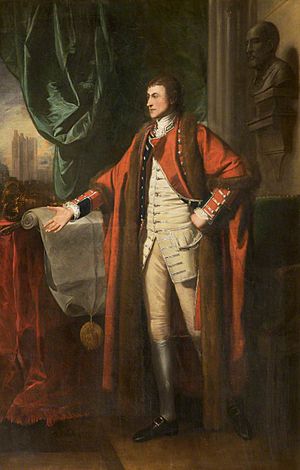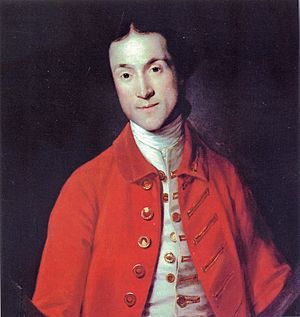Richard Grosvenor, 1st Earl Grosvenor facts for kids
Quick facts for kids
The Earl Grosvenor
|
|
|---|---|
 |
|
| Personal details | |
| Born | 18 June 1731 Eaton Hall, Cheshire, England |
| Died | 5 August 1802 (aged 71) |
| Resting place | St Mary's Church, Eccleston, Cheshire, England |
| Political party | Tory |
| Spouse | Henrietta Vernon |
| Children | 4, including Robert |
| Parents | Sir Robert Grosvenor, 6th Baronet (father) Jane Warre (mother) |
Richard Grosvenor, 1st Earl Grosvenor (born June 18, 1731 – died August 5, 1802) was an important English landowner and politician. He was a member of the Tory party. He served in the British Parliament for the city of Chester from 1754 to 1761. Later, he became a peer, which meant he gained a special title and a seat in the House of Lords.
Contents
Early Life and Education

Richard Grosvenor was born at Eaton Hall in Cheshire, England. He was the older son of Sir Robert Grosvenor, 6th Baronet, and Jane Warre. He went to Oriel College, Oxford, a famous university. He earned his first degree in 1751 and a higher degree in law in 1754.
Political Career and Public Service
Richard Grosvenor started his political career in 1754. He became a Member of Parliament (MP) for Chester. He represented the city until 1761. In that year, he was given the title of Baron Grosvenor. This meant he moved from the House of Commons to the House of Lords.
He also served as the mayor of Chester in 1759. In 1769, he paid for the construction of the Eastgate in Chester. He also expanded his family's land by buying the villages of Belgrave and Eccleston. When his father passed away in 1755, Richard became the 7th Baronet.
Richard Grosvenor's political views changed over time. He started as a Tory, like his father. Later, he began to support the ideas of William Pitt the Elder. In 1758, he publicly supported Pitt's government. Because of this, he was made Baron Grosvenor in 1761.
However, when another Tory, the Earl of Bute, became Prime Minister, Grosvenor changed his support. When Pitt returned to power in 1766, Grosvenor supported him again. In the 1770s, he supported Lord North during the American War of Independence. He voted against a bill proposed by Charles James Fox in 1783. As a reward, William Pitt the Younger gave him the title of Earl Grosvenor in 1784.
Interests and Achievements
Beyond politics, Richard Grosvenor had many interests. He loved collecting art and was very involved in horse racing. He bought many artworks from Italy. He also purchased paintings from famous artists like Benjamin West, Thomas Gainsborough, Richard Wilson, and George Stubbs.
He was a major supporter of the writer and journalist William Gifford. In 1788, a collection of writings from his home, Eaton Hall, was published. It was called The Eaton Chronicle, or The Salt-Box. In 1777, he became a Fellow of the Royal Society. This is a group that promotes science.
Grosvenor was very passionate about horse racing. He set up stud farms (places where horses are bred) in Wallasey and at Eaton. His horses were very successful. They won the famous Derby race three times and the Oaks race six times. His racing colors were yellow with a black cap.
In the 1760s, Grosvenor lived in Aubrey House in London. Today, a special blue plaque on the house remembers him and other important people who lived there.
Family Life and Legacy
On July 19, 1764, Richard Grosvenor married Henrietta Vernon. They had four sons together.
Richard Grosvenor passed away in 1802. He was buried in his family's burial place at St Mary's Church, Eccleston. His eldest son, Robert, took over the family estate at Eaton Hall.

